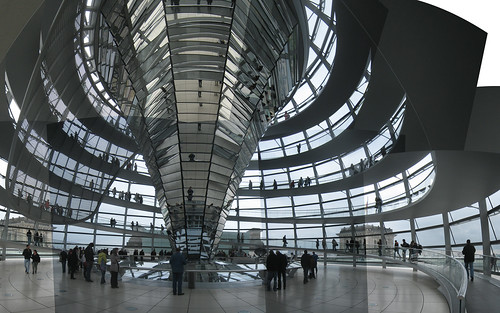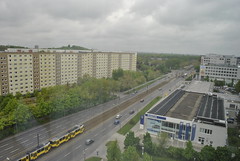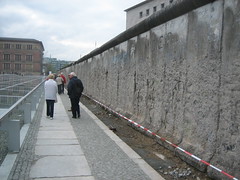I stayed in Berlin from Thursday, May 6 through Sunday the 9th, during my travels through Germany. Berlin was quite a different beast than Munich – much larger, spread out, and modern. The six hour trip on the Intercity Express was relaxing, but when I arrived it was pouring down rain, which made for a less than welcoming arrival.
I stayed at a large corporate hotel a good distance from the center, among the super blocks of eastern Berlin. I took the S-Bahn from the new, multi-level Hauptbahnhof and switched to a tram at Alexanderplatz. From the tram I had to walk in the rain – which I ended up walking up the wrong street at first so was not too pleased. The area was characterized by wide, multi-lane thoroughfares with enormous blocks bearing large, ubiquitous apartment buildings. (photo below left) The scale was oppressive, unlike anything I’ve seen before. Once I got to my hotel room – which was the most familiar (American) type of room I had stayed in, yet the least comfortable (too large for one person) – I retreated to a nap for a few hours as the rain tired itself out.
Later that evening I took the tram back to Alexanderplatz (photo above right) to eat and look around. Alexanderplatz is a large, open public square surrounded by large retail centers and a major local rail and transit station. It has a very open (almost too open) feel so is certainly not the intimate public square you’d find in Munich or other towns. Very close by is the distinctive Rathaus (City Hall) and Fernsehturm TV tower. On the square there is a large, five-story Kaufhof department store, rebuilt in 2004, at the same time as a major underground rail project. More buildings have been constructed or redeveloped since, with more to coming.
On Friday I returned to Alexanderplatz to explore more of Berlin’s mitte (city center). The sky was still gloomy, but at least no rain. I spent sometime looking at an outdoor exhibit about the GDR and Alexanderplatz demonstration, until some punk “from Poland” started heckling me for money and wasn’t too happy when I wouldn’t give him any. I then took a bus west a little bit to the Reichstag Building, home of the Bundestag, Germany’s parliament. I waited about an hour to go inside and see the signature dome (large photo at top). It was interesting and provided great views of central Berlin.
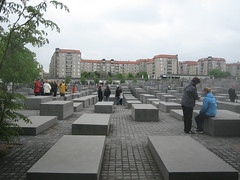 I continued walking, past the Brandenburg Gate, which was actually not that large, and then to the recently-built Memorial to the Murdered Jews of Europe, a large block composed of concrete slabs varying in height, forming a series of gridded pathways undulating along the terrain. It is intended to create a sense of disorientation and confusing, while representing “a supposedly ordered system that has lost touch with human reason.” (Wikipedia) The memorial is very interesting architecturally and symbolically, but is not without criticism regarding its merit (as a memorial or more for tourism), a construction company with distant Nazi ties, and evidently no where inside or around the memorial does it say what it commemorates. From my own observation – the behavior of visitors seemed a bit disrespectful with kids running around and people casually relaxing on the lower slabs. Like I said, interesting space, but not sure if it is the best use of such a large space in the middle of an urban center struggling for connectivity and human scale, nor the best way to remember the millions of Holocaust victims.
I continued walking, past the Brandenburg Gate, which was actually not that large, and then to the recently-built Memorial to the Murdered Jews of Europe, a large block composed of concrete slabs varying in height, forming a series of gridded pathways undulating along the terrain. It is intended to create a sense of disorientation and confusing, while representing “a supposedly ordered system that has lost touch with human reason.” (Wikipedia) The memorial is very interesting architecturally and symbolically, but is not without criticism regarding its merit (as a memorial or more for tourism), a construction company with distant Nazi ties, and evidently no where inside or around the memorial does it say what it commemorates. From my own observation – the behavior of visitors seemed a bit disrespectful with kids running around and people casually relaxing on the lower slabs. Like I said, interesting space, but not sure if it is the best use of such a large space in the middle of an urban center struggling for connectivity and human scale, nor the best way to remember the millions of Holocaust victims.
I then walked to Postdamer Platz, another significant public “square” in Berlin. It was a circular space enclosed by modern glass towers, somewhat disconnected from the surrounding streets. I believe there was a movie theater in there, as well as a number of restaurants, but mostly office space. It wasn’t too active when I was there.
Next I came upon the Topography of Terror, the former site of the Gestapo and SS headquarters, now an outdoor museum containing a remaining section of the Berlin Wall. A new contemporary building houses an exhibit that’s very informative. I continued a few blocks away to the infamous Checkpoint Charlie. The setting, again, was not really what I expected – I came to it quite suddenly. The area was very touristy, which seems unfortunate for such an important place in Berlin and Germany’s history.
I walked back north a little way to the mitte, which appeared on a map to be more of nice “downtown” area with a cohesive grid of streets. Despite being west of the river (which I originally assumed was the “center” of the city and therefor generally the divide of former East and West Berlin), the mitte is all still in the former East Berlin. The blocks were a bit large – nothing like the block sizes out by my hotel though – and not very attractive or active. With mostly large, boxy office buildings and wide streets it reminded me of parts of downtown Washington DC.
I did come upon Gendarmenmarkt, a large square dating back to the 17th century, defined by the historic Konzerthaus, flanked by German and French cathedrals. There was a guy sitting by the modest central fountain playing a horn to a familiar tune. The sun also began to peak out from the clouds, which it had been hiding behind since I arrived in Germany.
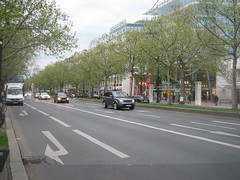 Feeling I had sufficiently seen the mitte, I took bus route 100 to the “downtown” of former West Berlin (photo left), dubbed “City of West” on my complimentary hotel city map. In between the east and western downtowns is an enormous Tiergarten (zoo). I had been a bit discouraged by the condition of Berlin so far, so was curious how different it’d be in the west. It was definitely more active than many areas I saw in the east, and seemed more cohesive with fewer gaps and gouges in the urban fabric. It was generally nice, but seemed pretty new and lacked uniqueness. I explored a few blocks before taking the U-Bahn (urban subway) a few stops, and then switched to the S-Bahn (suburban rail) to check out the nearby city of Potsdam.
Feeling I had sufficiently seen the mitte, I took bus route 100 to the “downtown” of former West Berlin (photo left), dubbed “City of West” on my complimentary hotel city map. In between the east and western downtowns is an enormous Tiergarten (zoo). I had been a bit discouraged by the condition of Berlin so far, so was curious how different it’d be in the west. It was definitely more active than many areas I saw in the east, and seemed more cohesive with fewer gaps and gouges in the urban fabric. It was generally nice, but seemed pretty new and lacked uniqueness. I explored a few blocks before taking the U-Bahn (urban subway) a few stops, and then switched to the S-Bahn (suburban rail) to check out the nearby city of Potsdam.
When I arrived I couldn’t tell which direction the city (center) was from the station. It was beginning to get dark and the station did not seem to be right in the middle. There was a lower-quality shopping mall within the station, including Kaufland – a Walmart-like discount store, presumably affiliated with Kaufhof. I stopped in to get a cheap duffel bag to alleviate my single overpacked and overweight suitcase for my remaining flights.
On Saturday, my last full day in Germany, I ventured from Berlin to Dessau, home of the Bauhaus. Of course there was much more I could’ve seen in Berlin, but one more day wasn’t going to make a large dent and I had one more day on my rail pass to use. Only deciding on this excursion the night before, another consideration of was Hamburg, which I decided against since it was further away and another very large city that would be difficult to take all in in one day anyway.
Berlin was a very interesting city to see, especially in contrast to Munich and the more romantic towns of southern Germany. Berlin has yet to fully recover from its not very distant woeful past. Redevelopment of significant places like Alexanderplatz and Postdamerplatz lack wholeness and good connectivity. Much of mitte “East Berlin” remains full of spatial gaps and large, mostly homogenous-use buildings and large blocks leave sidewalks barren of activity. The Berlin Wall and associated history dominate tourism, casting an inevitable shadow over the city that will prevent it from ever healing completely – at least from a tourist or visitor’s perspective. Most of all my disappointment in Berlin was the poor urban form and scale I experienced that leaves many places feeling uncomfortable, anonymous and incomplete.
See all photos from Berlin here.
